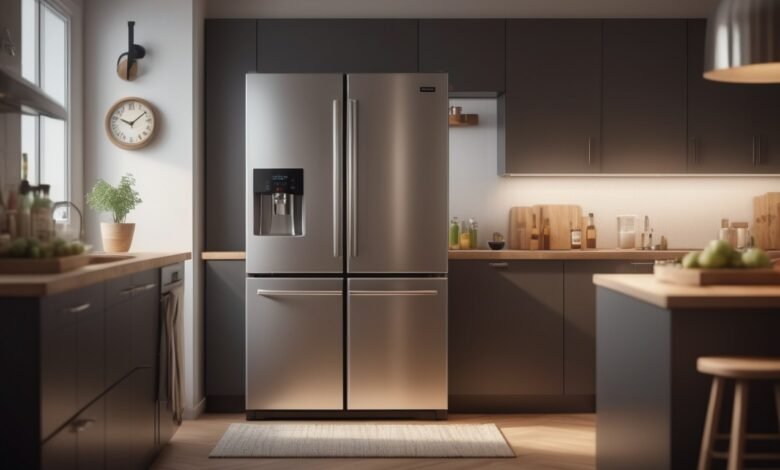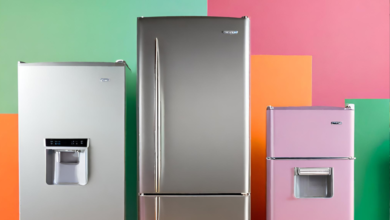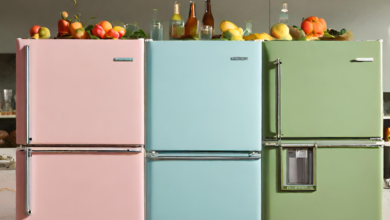Innovative Kitchen Appliances with Built-In Connectivity: A Deep Dive into Smart Refrigerators

The kitchen, once a bastion of tradition, has undergone a remarkable transformation with the advent of innovative kitchen appliances featuring built-in connectivity. Among these groundbreaking devices, smart refrigerators stand out as a beacon of technological advancement, seamlessly integrating connectivity features to enhance our daily culinary experiences. In this comprehensive blog, we will explore the intricacies of these innovative kitchen appliances, focusing on smart refrigerators and their role in reshaping the modern kitchen landscape.
I. The Evolution of Kitchen Appliances
A. A Journey from Conventional to Connected
The kitchen has come a long way from its humble beginnings, with appliances evolving from manual and mechanical to intelligent and interconnected. The incorporation of built-in connectivity marks a pivotal moment in this journey, ushering in an era of unprecedented convenience and efficiency.
B. Rise of the Smart Kitchen
The concept of the smart kitchen has gained prominence in recent years, with homeowners seeking ways to streamline their cooking processes and improve overall kitchen management. Smart refrigerators, equipped with built-in connectivity, serve as the cornerstone of this transformative shift.
II. Understanding Built-In Connectivity
A. Unveiling the Connectivity Concept
Built-in connectivity in kitchen appliances refers to the integration of technologies like Wi-Fi, Bluetooth, and IoT that enable seamless communication between devices and the internet. In the context of smart refrigerators, this connectivity extends beyond conventional cooling functions, turning the appliance into a central hub for kitchen management.
B. The Birth of Smart Refrigerators
The inception of smart refrigerators was fueled by the desire to create appliances that could adapt to modern lifestyles. These refrigerators leverage connectivity to provide users with real-time information, remote control capabilities, and a host of innovative features.
III. Features Redefining Kitchen Experiences
A. IoT Connectivity
1. Remote Monitoring and Control
Smart refrigerators with built-in connectivity feature dedicated mobile apps, allowing users to monitor and control various functions remotely. This capability proves invaluable for adjusting temperature settings, managing inventory, and receiving notifications on the go.
2. Inventory Management
Built-in cameras in smart refrigerators capture images of the contents, offering users a visual inventory accessible through mobile apps. This feature streamlines grocery shopping, prevents overstocking, and facilitates efficient meal planning.
B. AI-Powered Intelligence
1. Adaptive Cooling
Artificial Intelligence (AI) algorithms optimize cooling efficiency in smart refrigerators. Adaptive cooling systems adjust temperature settings based on usage patterns, ensuring optimal conditions for different types of food items.
2. Food Recognition
AI enables smart fridges to recognize and catalog different food items. This feature not only aids in inventory management but also contributes to energy efficiency by suggesting ideal temperature settings for specific items.
C. Energy Efficiency
1. Eco-Friendly Practices
Smart refrigerators often incorporate eco-friendly refrigerants, aligning with sustainability efforts. These refrigerants have a reduced environmental impact while maintaining high cooling efficiency.
2. Energy Consumption Monitoring
Users can monitor real-time energy consumption, empowering them to make conscious decisions and contribute to a more sustainable lifestyle. Detailed insights into energy usage foster awareness and encourage eco-friendly practices.
IV. Integration with the Smart Home Ecosystem
A. Seamless Connectivity
1. Interconnected Appliances
Smart refrigerators seamlessly integrate with other smart kitchen devices, creating a unified ecosystem. For example, when the fridge detects low stock of a particular item, it can communicate with a smart grocery list app or a virtual assistant to streamline the replenishment process.
2. Automated Scenarios
Integration with smart home automation systems enables users to create custom scenarios. A “Cooking Mode” scenario, for instance, could involve the smart refrigerator communicating with the oven and stove to ensure coordinated and synchronized cooking.
B. Voice Control
1. Virtual Assistant Integration
Many smart refrigerators support voice control through popular virtual assistants like Amazon Alexa and Google Assistant. This hands-free functionality enhances accessibility, allowing users to perform tasks, receive information, and control settings using voice commands.
2. Natural Language Processing Advancements
Advancements in natural language processing enhance the effectiveness of voice control. Users can interact with their refrigerators using more natural and conversational language, making the experience intuitive and user-friendly.
V. Enhanced User Experience
A. Interactive Displays
1. Touchscreen Panels
Smart refrigerators often feature interactive touchscreen panels on the door. These panels serve as centralized hubs for controlling various functions, displaying recipes, and even streaming content. The intuitive interface enhances the overall user experience, making the refrigerator a multifunctional device.
2. Notifications and Reminders
Interactive displays show notifications and reminders, such as expiration dates, upcoming events, or maintenance alerts. This proactive approach helps users stay organized and ensures the freshness of their food items.
B. Smart Applications
1. Culinary Creativity with Recipe Suggestions
Built-in applications provide recipe suggestions based on the available ingredients in the refrigerator. Users can explore new culinary possibilities, making the cooking experience more creative and enjoyable.
2. Calendar Integration for Seamless Planning
Smart refrigerators often integrate with digital calendars, allowing users to keep track of important dates, appointments, and events. This integration adds another layer of convenience by centralizing information in a commonly accessed location.
VI. Security and Privacy Considerations
A. Biometric Access
1. Fingerprint Recognition
To enhance security, some smart refrigerators come equipped with biometric access control, such as fingerprint recognition. This ensures that only authorized individuals can access the contents of the refrigerator, adding an extra layer of privacy.
2. Privacy Controls
Manufacturers prioritize user privacy by implementing robust security measures and giving users control over data sharing settings. Users can manage permissions for different features, ensuring a secure and personalized experience.
VII. Future Trends and Innovations
A. Quantum Computing in Kitchen Appliances
1. Optimized Energy Consumption
The integration of quantum computing in kitchen appliances, including refrigerators, holds the promise of further optimizing energy consumption. Quantum algorithms can analyze and process data at unprecedented speeds, leading to more efficient cooling processes.
2. Enhanced AI Capabilities
Quantum computing’s computational power can enhance AI capabilities in smart refrigerators, enabling more accurate food recognition, personalized recommendations, and adaptive learning.
Conclusion
In conclusion, innovative kitchen appliances with built-in connectivity, particularly smart refrigerators, are revolutionizing the way we approach kitchen management. The fusion of IoT technology, AI intelligence, and seamless connectivity has elevated these essential appliances into intelligent companions that cater to our culinary needs with precision and sophistication. As these technologies continue to evolve, the future holds exciting possibilities, promising not only increased efficiency and convenience but also a more sustainable and interconnected kitchen experience. Embracing these innovations ensures that our kitchens become hubs of innovation, providing a seamless and enjoyable cooking journey for all.






